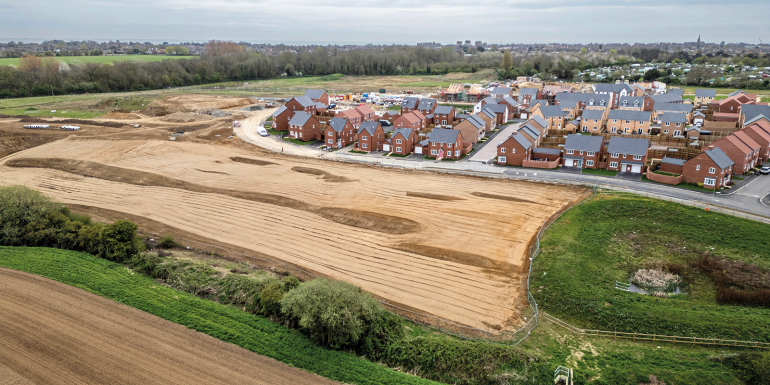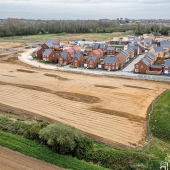Slash and burn?

The Nature Levy in the Planning and Infrastructure Bill (Part 3) making its way through parliament has been dubbed a ‘licence to kill’, but is it really that bleak?
The UK government website describes the Planning and Infrastructure Bill as “central to the plan to get Britain building again … The bill will speed up and streamline the delivery of new homes and critical infrastructure, supporting delivery of the government’s Plan for Change milestones of building 1.5 million safe and decent homes in England and fast-tracking 150 planning decisions on major economic infrastructure projects by the end of this parliament.”
Nature recovery
So far, so good – but it is part 3 of the bill, ‘Development and nature recovery’, that has ruffled some feathers. The government states: “Currently, where development is required to discharge an environmental obligation relating to protected habitats and species there is often little or no strategic co-ordination as to how these obligations are or should be discharged. As the system stands, development is often delayed until sufficient mitigation is put in place. The time it takes to secure mitigations can range from a number of months to a number of years. Assessing the environmental impact of a development requires a high level of technical knowledge and a bespoke assessment is required, even for small developments.
“Each development must then be linked to specific mitigation measures with development being blocked where such measures are not readily available. While this approach addresses the specific impact of a development, by not taking a holistic view, mitigation measures may not secure the best outcomes for the environment. These delays can slow housing delivery, with accompanying burdens on developers and local authorities.”
The UK government states that the current system of district level licensing and nutrient neutrality schemes is “complex and inefficient”, while this bill offers one fund – the Nature Restoration Fund – that developers pay into to meet their environmental obligations relating to protected sites and species. A ‘designated delivery body’ (such as Natural England) will set out the action to be taken to address the impact that development has on the protected site or species “and, crucially, how these actions go further than the current approach and support nature recovery”.
By making a straightforward payment, the developer will pass the responsibility of sourcing and delivering mitigations onto the experts, freeing the developer to focus on the development. Ministers say the new bill will speed up housing developments and large infrastructure projects. Conservationists say it allows developers to avoid meeting environmental obligations to protect habitats and species – such as barn owls, otters, bats and newts – at the site of their project.
Planning and Infrastructure Bill
The bill has five overarching objectives:
- A clearer and faster consenting process for critical infrastructure.
- A more strategic approach to nature recovery.
- Improved certainty and decision-making in the planning system “shaped by local communities and reflecting the views of local residents”.
- Unlocking land and securing public value for large-scale investment.
- Introducing mechanisms for cross-boundary strategic planning.

The counter view
“The headline claims are bold – that this new levy will simplify processes, accelerate housebuilding and restore nature through an ‘overall improvement test’. But the reality is far more troubling. This proposal allows companies to ‘buy out’ of their legal obligations to nature, and in doing so, dismantles key safeguards that have protected nature for decades,” states a letter that more than 40 economists, conservationists and former government advisors sent to every MP in April.
Their concern stems from the apparent conflict of interest being proposed, that “Natural England will write the conservation plans and assess their success, all the while being reliant on the new Nature Levy income to fund its own administration”.
That, and they point out the proposed new system operates as a “destroy first and ask questions later” principle that is based on a “misguided” notion of what is causing the planning issues in the first place. “The government’s rhetoric – that wildlife laws are delaying house building – is simply false. In our collective experience, delays are driven by under-resourced planning authorities, infrastructure bottlenecks and industry-led viability constraints.”

Will barn owls and smooth newts be species at risk?
Voices of dissent
There is almost no evidence nature protections or environmental legislation block or hold up development, notes Richard Broadbent, Environmental Lawyer at Freeths LLP. He says it is deeply frustrating that the government is pushing major changes to conservation law without supporting data or research.
“This is reminiscent of Defra’s Habitats and Wild Birds Directives Implementation Review published in March 2012. This Defra report found that of the 26,500 land use consultations Natural England received annually, it only objected to less than 0.5% on Habitats Regulations grounds and most of those objections were successfully dealt with at the planning stage.
“A Natural England information request I carried out in 2022, after the previous government awarded itself powers to gut the Habitats Regulations in the Environment Act 2021, found that in the year April 2021 to March 2022 out of 32,056 land use consultations, just 15 were objected to on Habitats Regulations grounds,” says Broadbent.
All of the environmental organisations point to a current system that is working well, such as the District Level Licensing for newts that “demonstrates it is possible to protect species and streamline development”.
The RSPB and the Wildlife Trusts are part of 60 environmental organisations calling for part 3 of the bill to be ditched, citing similar figures: analysis of 17,433 planning appeals in England in 2024 found that newts were relevant in just 140 (0.8%) planning appeals and bats in 432 (2.48%).
In a separate letter to the environment secretary, the Chartered Institute of Ecology and Environmental Management said part 3 of the bill effectively allowed on-site habitats and species to be “wantonly destroyed to make way for development”, with the vague hope that it would be restored somewhere else at some future point in time. “[This] is quite evidently a catastrophically wrong approach.” The progress of the bill is ongoing.
Read the full bill and its progress at b.link/Parl_PIB
Read the letter to MPs at b.link/RSKWilding_letter
Read more at b.link/Guardian_wildlife









